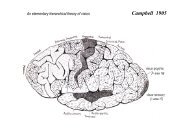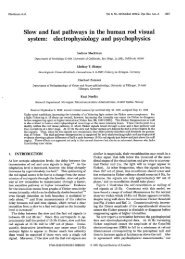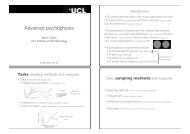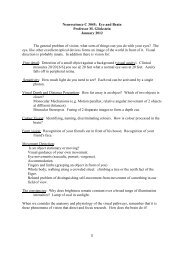Fundamentals of neuroscience: cells, axons, and synapses
Fundamentals of neuroscience: cells, axons, and synapses
Fundamentals of neuroscience: cells, axons, and synapses
Create successful ePaper yourself
Turn your PDF publications into a flip-book with our unique Google optimized e-Paper software.
Action Potential Propagation in Myelinated AxonsVoltage ClampTwo-electrode voltage clamp <strong>of</strong> squid axon, after Hodgkin & HuxleyExtracellular+ +- -IntracellularMyelinated nervemembraneNa +K +<strong>and</strong> so forth• Effectively the action potential is propagated from one node <strong>of</strong> ranvierto the next. This is referred to as Saltatory Conduction.• The net result <strong>of</strong> this is that an action potential can travel morequickly by jumping along a myelinated axon rather than by beingconventionally propagated along an umyelinated axon.The voltage-clamp technique keeps the voltage across themembrane constant so that the amplitude <strong>and</strong> time course<strong>of</strong> <strong>of</strong> ionic currents can be measuredVoltage Clamp Reveals Ionic CurrentsVoltage Clamp recordings from CellsTwo electrode voltage clamp(large <strong>cells</strong> eg oocytes)MeasureVoltage-70mVInjectCurrentSingle electrodevoltage clamp(neurones) • Measure voltage• is it what we want ?• Pass current to adjustvoltageMembranecurrents-70mVTEA - TetraEthylAmmonium – blocks K + currentsTTX - TetrodoToXin – blocks Na + currentsWhole Cell (Patch) recordingsExtracellular Recording methodswholecellMembranecurrentsGlycine 50uM100pAMicroelectrodeSingle neurone (unit) spikes500uVFlash1 sGlycine 50uMneuroneField Potential Recordingisolatedpatch5pA1 sFlash7










